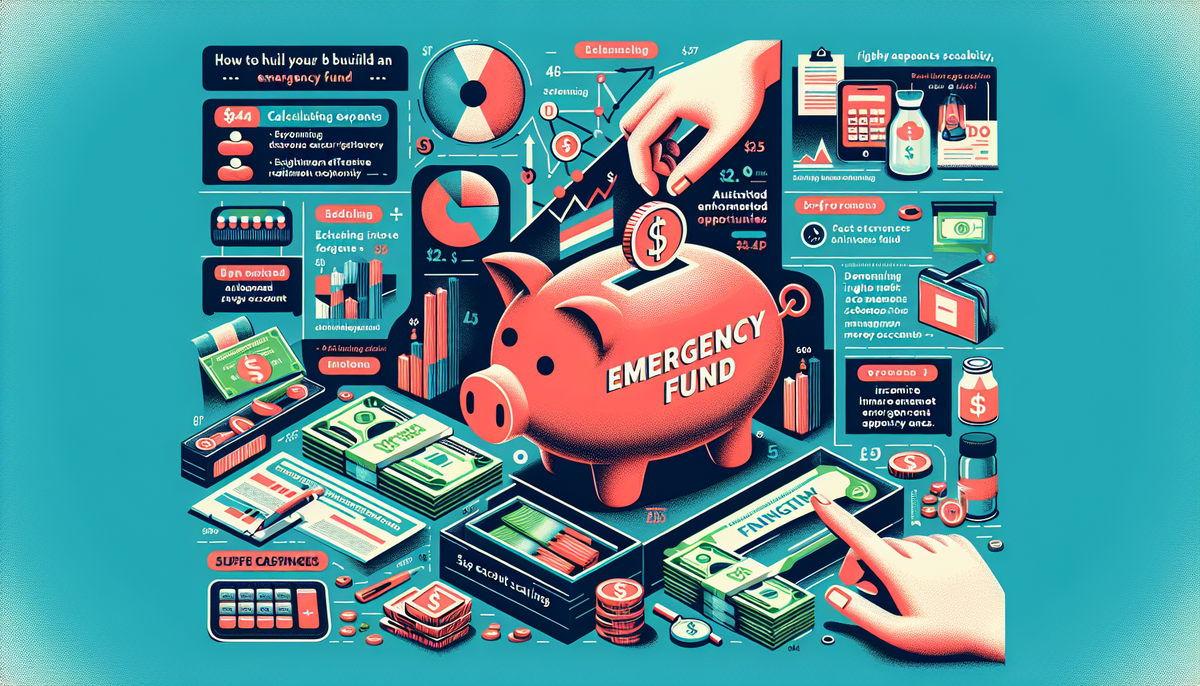How to Build an Emergency Fund Step-by-Step

How to Build an Emergency Fund Step-by-Step
Building an emergency fund is a critical step toward achieving financial stability and peace of mind. In a world of economic uncertainty, having a safety net for unexpected expenses is not a luxury—it's a necessity. This comprehensive guide will walk you through the process of building a robust emergency fund, from figuring out how much you need to save to choosing the right place to store your cash. By the end of this article, you'll have a clear, actionable plan to create a financial cushion that protects you from life's unexpected turns. Financial planning can seem daunting, but with the right strategy, you can save money effectively and secure your future.
What is an Emergency Fund?
An emergency fund is a pool of money you set aside for unforeseen financial emergencies. Think of it as a personal safety net that can catch you when you fall. This isn't money for a vacation or a down payment on a car; it's strictly for unexpected events that could otherwise derail your finances. Common examples include job loss, medical emergencies, urgent home repairs, or unexpected car trouble. The primary purpose of an emergency fund is to cover these costs without having to dip into your long-term investments, rack up high-interest credit card debt, or take out a loan. It's the first line of defense in your personal finance strategy and a cornerstone of sound financial planning.
Why an Emergency Fund is Non-Negotiable for Financial Health
Having an emergency fund is one of the most important things you can do for your financial well-being. It provides a buffer that can help you weather financial storms without sinking into debt. When you have a solid emergency fund, you're less likely to make panicked financial decisions. Instead of worrying about how you'll pay for an unexpected expense, you can focus on resolving the issue at hand. This reduces stress and gives you the freedom to make clear-headed choices. Furthermore, an emergency fund can prevent a minor setback from turning into a major financial crisis. It allows you to maintain your financial momentum, even when faced with unexpected challenges, making it a crucial tool to save money and stay on track with your financial planning goals.
How Much Should You Have in Your Emergency Fund?
The standard recommendation is to have three to six months' worth of essential living expenses saved in your emergency fund. This range allows for flexibility based on your personal circumstances. For example, if you have a stable job and multiple sources of income, you might be comfortable with a three-month fund. However, if you're a freelancer, a single-income household, or have a less stable job, a six-month fund would be more appropriate. The key is to have enough to cover your basic needs while you get back on your feet after a financial setback. Here’s how to calculate your target amount:
Step 1: Calculate Your Monthly Essential Expenses
Start by listing all your essential monthly expenses. These are the costs you absolutely must cover each month, such as housing (rent or mortgage), utilities, food, transportation, insurance, and any debt payments. Be sure to exclude discretionary spending like dining out, entertainment, or vacations. The goal is to get a clear picture of your bare-bones budget. Add up these expenses to find your total monthly essential living costs.
Step 2: Determine Your Savings Goal (3 to 6 Months)
Once you have your total monthly essential expenses, multiply that number by three and then by six to determine your savings goal range. For example, if your essential monthly expenses are $3,000, your emergency fund goal would be between $9,000 and $18,000. Deciding where you fall in this range depends on your personal risk tolerance and financial situation. Having a clear goal will make it easier to track your progress and stay motivated on your journey to save money.
The Step-by-Step Guide to Building Your Emergency Fund
Building an emergency fund takes time and discipline, but it's an achievable goal with the right approach. By following these steps, you can systematically build your savings and create a strong financial foundation. This part of your financial planning is all about taking consistent action.
Step 1: Start with a Small, Achievable Goal
If you're starting from scratch, the idea of saving thousands of dollars can be overwhelming. To avoid feeling discouraged, start with a smaller, more manageable goal, like saving your first $500 or $1,000. This is often called a "starter" emergency fund. Achieving this initial milestone will give you a sense of accomplishment and motivate you to keep going. It also provides a small cushion while you work toward your larger goal.
Step 2: Open a Separate High-Yield Savings Account
It's crucial to keep your emergency fund separate from your regular checking account. This helps you resist the temptation to dip into it for non-emergency expenses. Open a high-yield savings account specifically for your emergency fund. These accounts offer higher interest rates than traditional savings accounts, allowing your money to grow faster. Look for an account with no monthly fees and easy access to your funds when you need them.
Step 3: Automate Your Savings
The most effective way to save money consistently is to make it automatic. Set up an automatic transfer from your checking account to your high-yield savings account each payday. Even a small amount, like $25 or $50 per week, can add up significantly over time. Automating your savings ensures that you're prioritizing your emergency fund without having to think about it. It’s a classic “set it and forget it” strategy that is a cornerstone of successful financial planning.
Step 4: Find Ways to Cut Expenses
To accelerate your savings, take a close look at your budget and identify areas where you can cut back. This could mean canceling unused subscriptions, cooking more meals at home, or reducing your entertainment spending. Track your spending for a month to see where your money is going, and then look for opportunities to trim the fat. Every dollar you save is another dollar you can put toward your emergency fund.
Step 5: Look for Opportunities to Increase Your Income
In addition to cutting expenses, consider ways to boost your income. This could involve taking on a side hustle, freelancing in your field, or selling items you no longer need. Any extra income you generate can be directed straight into your emergency fund, helping you reach your goal much faster. This two-pronged approach of cutting costs and increasing income is a powerful way to supercharge your efforts to save money.
Where to Keep Your Emergency Fund: The Best Account Options
When it comes to storing your emergency fund, you need an account that is both safe and easily accessible. The last thing you want is to have your money tied up in a risky investment or an account that's difficult to withdraw from when you need it most. Here are the best options for your emergency savings:
High-Yield Savings Accounts
As mentioned earlier, high-yield savings accounts are an excellent choice for an emergency fund. They are FDIC-insured, meaning your money is protected up to $250,000. They also offer competitive interest rates, which helps your savings keep pace with inflation. Most online banks offer high-yield savings accounts with no fees and easy online access, making them a convenient and effective option for your financial planning needs.
Money Market Accounts
Money market accounts are another solid option. They are similar to savings accounts but may offer slightly higher interest rates and sometimes come with check-writing privileges or a debit card. Like savings accounts, they are FDIC-insured, making them a safe place to store your cash. When comparing money market accounts, pay attention to any minimum balance requirements or transaction limits.
Conclusion: Your Journey to Financial Peace of Mind
Building an emergency fund is a journey, not a destination. It requires patience, discipline, and a commitment to your financial health. By following the steps outlined in this guide, you can create a financial safety net that will protect you from life's unexpected challenges. Start today by setting a small, achievable goal and taking the first step toward a more secure financial future. Your future self will thank you for making the smart choice to save money and engage in thoughtful financial planning.



